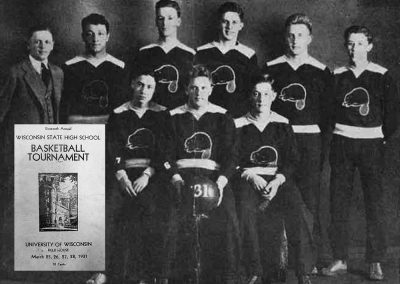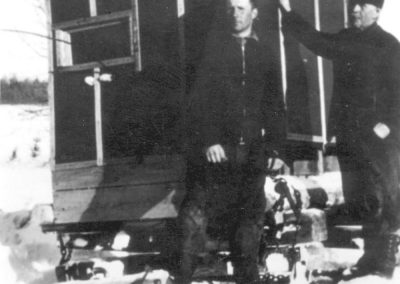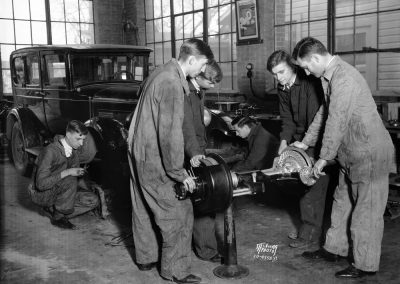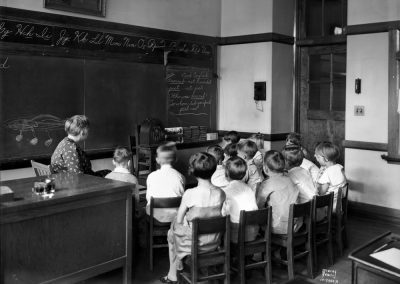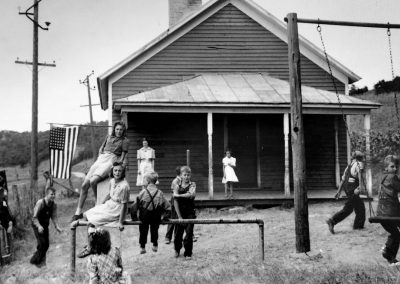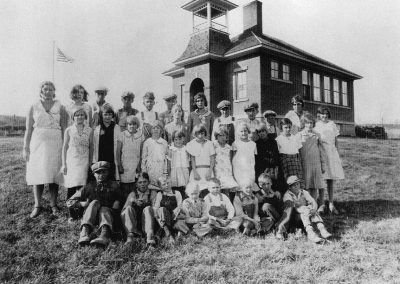The Cumberland High School basketball team lost in the quarterfinals of the 1931 state tournament to Watertown, 17-13. Wisconsin High (later known as the University of Wisconsin High School, which was created and maintained by the University of Wisconsin-Madison as part of its teacher education program and closed in 1964) beat Racine Park, 21-19, to win the championship.
 The 1930s
The 1930s
The Great Depression dominated the decade. Unemployment struck about one-fourth of the nation’s labor force, creating circumstances that local governments were ill-equipped to handle. By the time Herbert Hoover left the White House in 1933, 10,000 banks and innumerable businesses had closed. Franklin Roosevelt’s New Deal provided a ray of hope, coupled with the president’s inspiring rhetoric.
If anything, the New Deal brought dramatic, new federal resources to states via infrastructure. During the decade, there was construction/improvement to more than 650,000 miles of roads, nearly 6,000 public schools, 8,000 parks and 13,000 playgrounds, among other public works. The Social Security Act of 1935 aimed to keep the average elderly citizen out of poverty.
Meanwhile, turmoil spread in Europe. In 1932, Germany faced an unemployment rate of 43%. Adolf Hitler’s election, just two days before Roosevelt’s, brought the Nazis to power, changing the face of history. The decade is also remembered for: Grant Wood’s American Gothic painting, the Dust Bowl, the Dionne quintuplets, Orson Welles’ War of the Worlds, the Hindenburg disaster and Amelia Earhart’s disappearance.
The WASB
- 1936: Delegate Gertrude Sherman of Milwaukee proposes a resolution, which passed unanimously, to urge the “WASB use every reasonable measure…to ward off unwarranted legislation which would take from local boards of education the control of schools.”
- 1937: A bylaw change updates member dues to include five categories ranging from $5 for school district communities of less than a population of 10,000 (56 communities) to $25 for districts over 100,000 (Milwaukee).
- 1938: Legislative information is prepared and distributed to members by WASB President R.W. Mills of the Fond du Lac School Board and Sam Meyers of the Racine School Board.
- 1939: Following a discussion, with delegates using microphones for the first time, a resolution passes directing the WASB to support eliminating tenure for female teachers upon marriage and for all teachers upon reaching the age of 65 and requiring a five-year probationary period.
- 1939: The WASB reports a $1,648.62 balance with 216 member districts.
WASB Presidents
1930 – Dr. F.T. Clark – Waupun
1931 – V.A. Lundgren – Marinette
1932 – V.A. Lundgren – Marinette
1933 – W. A. Taege – Wausau
1934 – W.A. Taege – Wausau
1935 – W.A. Taege – Wausau
1936 – W.J. Sleeman – Superior
1937 – W.J. Sleeman – Superior
1938 – R.W. Mills – Fond du Lac
1939 – R.W. Mills – Fond du Lac
Our State
- 1930: The state’s public-school enrollment is 541,283.
- 1932: Wisconsin is the first to authorize monetary benefits for unemployed workers.
- 1933: Wisconsin is the first to prohibit the use of race or national origin as a factor in hiring teachers; Wisconsin votes to repeal the 18th Amendment, returning an estimated 8,500 brewery workers to jobs.
- 1935: Wisconsin is the first to require “adequate instruction in the conservation of natural resources” to certify someone to teach science and social studies.
- 1937: Wisconsin requires a state-issued teacher’s license — a lifetime license needing no further requirements or training.
Our Nation
- 1930: 3M invents Scotch tape; Blondie hits the comic pages; and more than half of high school-age youth are receiving a secondary education (twice the percentage from 1920).
- 1932: Laura Ingalls Wilder publishes Little House in the Big Woods; U.S. Route 66 opens from Chicago to Los Angeles; and the Dow Jones Average bottoms out at 41.22, a 90 percent drop from September 1929.
- 1933: Prohibition is repealed; Midwest farmers strike against falling farm prices; and Franklin Roosevelt gives his first fireside chat.
- 1935: Allis-Chalmers develops the first one-person, drivable, mechanical combine harvester; and Monopoly is on the game shelf.
- 1936: Track star Jesse Owens wins four gold medals and sets three world records at the Olympics in Berlin.
- 1939: The NAACP creates a fund to battle segregation; and on the “silver screen,” Judy Garland longs for home in The Wizard of Oz and Clark Gable’s Rhett Butler frankly doesn’t give a damn in Gone With the Wind.
